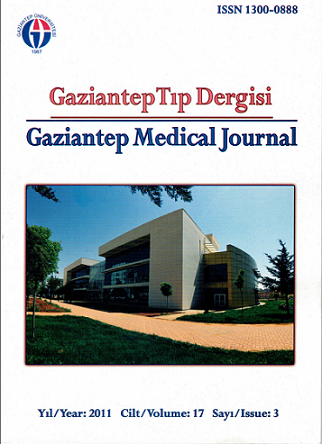Analysis of C-reactive protein in pyelonephritis
Piyelonefritte C-reaktif protein analizi
DOI:
https://doi.org/10.5455/GMJ-30-2011-46Keywords:
Bacterial agents, C-reactive protein, infection, pyelonephritis, urinaryAbstract
Urinary tract infection especially pyelonephritis is a common condition worldwide caused by different uropathogens. The hostresponse parameters like C-reactive protein (CRP) are important inflammatory markers and diagnostic tests. The aim of this study was to assess the usefulness of CRP in urinary tract infection- pyelonephritis caused by different bacteria for defining the urinary tract infection (UTI). A total of fifty patients with clinical symptoms of pyelonephritis referred to Al-Kindi Teaching Hospital (Baghdad, Iraq), were investigated from October 2009 to November 2009. Clean-catch midstream urine of the patients was collected. Urine specimens were cultured for isolation of the microbial agents of UTI. The isolated bacteria were identified using biochemical tests. CRP were assessed in relation to the inflammatory responses. The most common isolated bacteria were Escherichia coli (40%), Enterobacter (20%) and Klebsiella (12%). The least frequent bacteria were Staphylococcus aureus (4%), Streptococcus pyeogenes (4%) and Streptococcus fecalis (4%). There was a significant difference (P<0.001) between systemic inflammatory responses (CRP) with urinary tract inflammatory response (pyuria). According to the findings of this study, CRP can be suggested as useful and valuable tests in pyelonephritis.
Metrics
References
Stamm WE, Hooton TM. Management of urinary tract infections in adults. N Engl J Med 1993;329(18):1328-34.
Foxman B. Epidemiology of urinary tract infections: incidence, morbidity, and economic costs. Dis Mon 2003;49(2):53-70.
Amin M, Mehdinejad M, Pourdangchi Z. Study of bacteria isolated from urinary tract infections and determination of their susceptibility to antibiotics. Jundishapur Journal of Microbiology 2009;2(3):118-23.
Jodal U. The immune response to urinary tract infections in childhood. I. Serological diagnosis of primary symptomatic infection in girls by indirect hemagglutination. Acta Paediatr Scand 1975;64(1):96-104.
Pylkkanen J. Antibody-coated bacteria in the urine of infants and children with their first two urinary tract infections. Acta Paediatr Scand 1978;67(3):275-9.
Craig JC, Wheeler DM, Irwig L, Howman-Giles RB. How accurate is dimercaptosuccinic acid scintigraphy for the diagnosis of acute pyelonephritis? A meta-analysis of experimental studies. J Nucl Med 2000;41(6):986-93.
Jodal U, Lindberg U, Lincoln K. Level diagnosis of symptomatic urinary tract infections in childhood. Acta Paediatr Scand 1975;64(2):201-8.
Morris MW, Davey FR. Basic examination of blood. In: Henry JB, editor. Clinical diagnosis and management by laboratory methods. 12th ed. Philadelphia: WB Saunders; 2001; 479-519.
Hutchison RE, Davey FR. Leukocytic disorders. In: Henry JB, editor. Clinical diagnosis and management by laboratory methods. 12th ed. Philadelphia: WB Saunders; 2001; 586-622.
Jodal U, Hanson LA. Sequential determination of C-reactive protein in acute childhood pyelonephritis. Acta Paediatr Scand 1976;65(3):319-22.
Hellerstein S, Duggan E, Welchert E, Mansour F. Serum Creactive protein and the site of urinary tract infections. J Pediatr 1982;100(1):21-5.
Forbes BA. Sahm DF, Weissfeld AS. Bailey and Scott's Diagnostic Microbiology, 12th edition, Mosby Elsevier, 2007; 842-55.
Mandell GL, Bennett JE Dolin R. Principles and practice of infectious diseases. Churchill Livingstone, 2005; 881-2.
MacFaddin JF. Biochemical tests for identification of medical bacteria. 3rd ed. Philadelphia: Lippincott Williams and Wilkins, 2000.
McPherson RA, Ben-Ezra J, Zhao S. Basic examination of urine. In: McPherson RA, Pincus MR, editors. Henry’s clinical diagnosis and management by laboratory methods. 21st ed. Philadelphia: Saunders Elsevier; 2007; 394-424.
Peltola H, Rasanen JA. Quantitative C-reactive protein in relation to erythrocyte sedimentation rate, fever, and duration of antimicrobial therapy in bacteraemic diseases of childhood. J Infect. 1982;5(3):257-67.
Lin DS, Huang SH, Lin CC, Tung YC, Huang TT, Chiu NC, et al. Urinary tract infection in febrile infants younger than eight weeks of Age. Pediatrics 2000;105(2):E20.
Garin EH, Olavarria F, Araya C, Broussain M, Barrera C, Young L. Diagnostic significance of clinical and laboratory findings to localize site of urinary infection. Pediatr Nephrol 2007;22(7):1002-6.
Ayazi P, Mahyar A, Hashemi HJ, Daneshi MM, Karimzadeh T, Salimi F. Comparison of procalcitonin and C-reactive protein tests in children with urinary tract infection. Iran J Pediatr 2009;19(4):381-6.
Meyrier A. Diagnosis and management of renal infections. Curr Opin Nephrol Hypertens 1996;5(2):151-7.
Astal ZY, Sharif FA. Relationship between demographic characteristics and community-acquired urinary tract infection. East Mediterr Health J 2002;8(1):164-71.
Kothari A, Sagar V. Antibiotic resistance in pathogens causing community-acquired urinary tract infections in India: a multicenter study. J Infect Dev Ctries 2008;2(5):354-8.
Downloads
Published
How to Cite
Issue
Section
License
Copyright (c) 2023 European Journal of Therapeutics

This work is licensed under a Creative Commons Attribution-NonCommercial 4.0 International License.
The content of this journal is licensed under a Creative Commons Attribution-NonCommercial 4.0 International License.


















